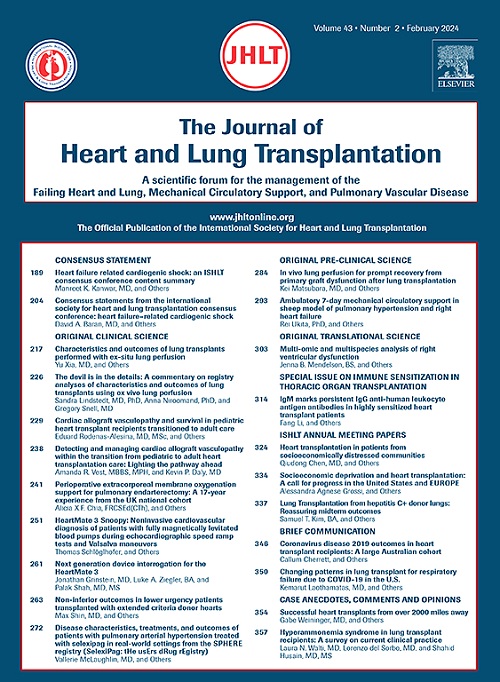Longitudinal assessment of bone mineral density changes after heart transplant: Implications for DXA screening frequency
IF 6.4
1区 医学
Q1 CARDIAC & CARDIOVASCULAR SYSTEMS
引用次数: 0
Abstract
We evaluated the rate of bone mineral density (BMD) loss after heart transplant using dual-energy X-ray absorptiometry (DXA) to determine the optimal DXA surveillance frequency. This retrospective study involved 153 heart transplant recipients aged 50 years or greater, followed for up to 5,614 (median 1,111) days after transplant. Mixed-effects models with random intercepts were used to evaluate BMD changes over time. We found that males had higher BMD at each site before transplant (p < 0.05 for all). Patients with normal BMD pretransplant had a greater rate of BMD loss compared to patients who had low BMD pretransplant at the femoral neck. The rate of BMD loss was fastest at the femoral neck in patients with normal BMD pretransplant, with an estimated annual femoral neck BMD decrease of 0.00905 g/cm2. The expected time for a patient to have a significant change in BMD is 1,332 days (95% confidence interval [909, 2,493] days).
心脏移植后骨密度变化的纵向评估:对DXA筛查频率的影响
我们使用双能x线吸收仪(DXA)评估心脏移植后骨密度(BMD)损失率,以确定最佳的DXA监测频率。这项回顾性研究包括153名年龄在50岁或以上的心脏移植受者,在移植后随访5614天(中位1111天)。采用随机截距的混合效应模型来评估骨密度随时间的变化。我们发现男性在移植前每个部位的骨密度都较高(p <;0.05)。与股骨颈移植前骨密度低的患者相比,移植前骨密度正常的患者骨密度损失率更高。移植前骨密度正常的患者股骨颈骨密度下降速度最快,估计每年股骨颈骨密度下降0.00905 g/cm2。患者骨密度发生显著变化的预期时间为1332天(95%置信区间[909,2493]天)。
本文章由计算机程序翻译,如有差异,请以英文原文为准。
求助全文
约1分钟内获得全文
求助全文
来源期刊
CiteScore
10.10
自引率
6.70%
发文量
1667
审稿时长
69 days
期刊介绍:
The Journal of Heart and Lung Transplantation, the official publication of the International Society for Heart and Lung Transplantation, brings readers essential scholarly and timely information in the field of cardio-pulmonary transplantation, mechanical and biological support of the failing heart, advanced lung disease (including pulmonary vascular disease) and cell replacement therapy. Importantly, the journal also serves as a medium of communication of pre-clinical sciences in all these rapidly expanding areas.

 求助内容:
求助内容: 应助结果提醒方式:
应助结果提醒方式:


